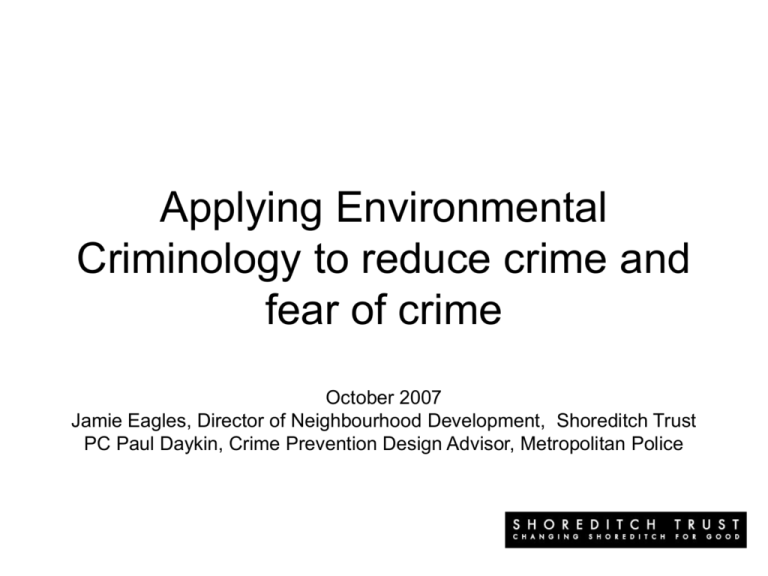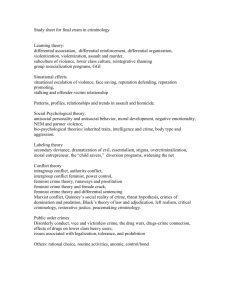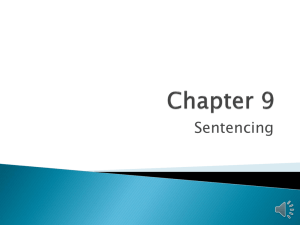Applying Environmental Criminology to reduce crime and fear of crime
advertisement

Applying Environmental Criminology to reduce crime and fear of crime October 2007 Jamie Eagles, Director of Neighbourhood Development, Shoreditch Trust PC Paul Daykin, Crime Prevention Design Advisor, Metropolitan Police Crime Theory In theory, there is no difference between theory and practice. But, in practice, there is. variously attributed to Chuck Reid or Jan L.A. van de Snepscheut There is nothing so practical as a good theory. Kurt Lewin Important Theories • Crime Pattern Theory – How do offenders find targets? – How can we keep offenders from targets? • Routine Activity Theory – What are the proximate conditions leading to crime? – How can we alter them? • Rational Choice – How do offenders make decisions? – How can we influence them? • Situational Crime Prevention – What types of prevention are available? – Which should we apply? Environmental Criminology • Traditional Criminology studies the origins of the offender’s criminal propensity. • Environmental Criminology studies the other elements of the criminal event. • EC stresses the importance of: – – – – – decision making by offenders and others routine activities environment imposed constraints place imposed constraints situation imposed constraints • EC assumes that offenders and victims generally use time and space in a normal (not unique or pathological) way. Crime Pattern Theory • • • • • • Offenders travel like everyone else They go no farther than they need to They find targets in their normal travels They do not use unusual methods of travel They try not to travel huge distances They often do not make special efforts to find targets Probability of Target Selection Routine Activity Theory When offenders & targets meet at places repeatedly without controllers crime concentrations appear. Crime Place Manager 3 Repeat Types: • Targets/Victims • Offenders • Places A First Cut at Prevention Remove one of these elements Place Manager Add one of these controllers Which of your partners can help with these tasks? 25 Crime Prevention Methods REDUCE PROVOCATIONS INCREASE RISK Extend guardianship Assist natural surveillance Reduce anonymity Use place managers Strengthen formal surveillance Reduce stress Avoid disputes Reduce emotional arousal Neutralize peer pressure Discourage imitation INCREASE THE EFFORT Harden targets Control access to facilities Screen exits Deflect offenders Control tools/weapons REDUCE REWARDS Conceal targets Remove targets Identify property Disrupt markets Deny benefits REMOVE EXCUSES Set rules Post instructions Alert conscience Assist compliance Control alcohol & drugs Rational Choice • • • • • • Offenders make choices like everyone else Balance of pain & gain, risk & reward, effort & ease. Fast and frugal “guestimates” will do Proximate Decision-making Ends v Means Rationality Evidence – Evaluations of situational crime prevention – Variability in displacement and diffusion of benefits – Association of offenders with opportunities Key Shoreditch Trust Interventions: Infrastructure Change: • Crime Prevention/Designing out Crime • Urban Realm Improvements Locality/Neighbourhood Management: • Safer Neighbourhood Office Some Useful resources • • • • www.securedbydesign.com http://www.jdi.ucl.ac.uk/ www.popcenter.org http://www.crimereduction.homeoffice.gov.uk/: – Home Office 251: http://www.homeoffice.gov.uk/rds/pdfs2/hors251.pdf – Home Office 252: http://www.homeoffice.gov.uk/rds/pdfs2/hors252.pdf Contacts PC Paul Daykin Crime Prevention Design Advisor Metropolitan Police Email: Paul.Daykin2@met.police.uk Telephone: 0208 217 3344 Jamie Eagles Director of Neighbourhood Development Shoreditch Trust Email: Jamie@Shoreditchtrust.org.uk Telephone: 020 7324 5104 www.shoreditchtrust.org.uk










